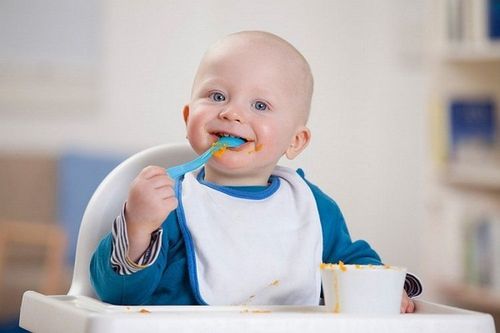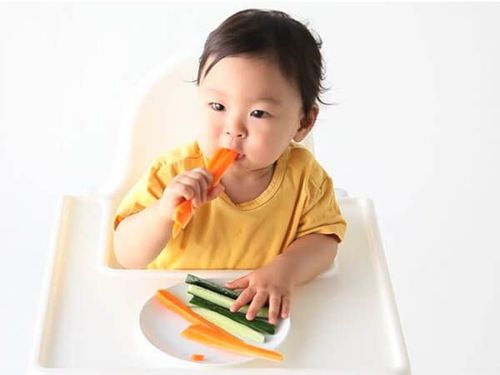This is an automatically translated article.
Self-directed weaning is a fairly simple activity, which means letting your baby feed himself right from the start. The term was originally coined by Gill Rapley, a former paramedic and midwife. According to the most recent research, most babies can start solid foods around 6 months of age, which is also the time when mothers are encouraged by doctors to wean according to the guidelines of the World Health Organization. (WHO).You just need to give the food to the baby with a suitable sized piece of food and if the child likes it, he will eat. No puree, no ice tray, no food blender, no potato masher, no baby rice, no fruit and veg... just you and your kids eating foods that aren't delicious. You and your family love to eat. That's the essence of baby-led weaning.
1. What is self-directed weaning?
Self-directed weaning first appeared in the UK, but it has attracted attention in the US and is currently one of the three most popular methods applied by mothers to their children when they first enter the weaning stage. . Instead of giving your baby food that is mashed or pureed with a spoon, with this method, you put the baby's food cut into small pieces directly on the tray and let the child hold the food on his own or on his own. eating contact. This method is called "baby command" so that the child chooses the food that the child likes and eats according to the child's needs instead of controlling the amount and speed of the child's food like other methods.Just like with traditional spoon feeding, babies will continue to get most of their nutrition from breast milk or formula until they get used to solid foods – usually around the first year of life. young.

Phương pháp này được gọi là “bé chỉ huy” để trẻ tự chọn thức ăn mà trẻ thích và ăn theo nhu cầu của trẻ
2. Signs that your baby is ready to start solids
The American Academy of Pediatrics (AAP) recommends that the best time for babies to introduce self-directed weaning is when the baby is exactly 6 months old or older with some of the following signs:At this age most baby is able to sit up on his own with very little support and grasp objects quite well. mouth and perform chewing while watching adults eat. Babies have also lost their tongue-push reflex – the reflex that causes them to push foreign matter out of their mouths, plus their intestines have developed the digestive enzymes needed to absorb solid foods. Children are not satisfied with the milk-only diet, get hungry quickly and ask for food continuously. However, self-directed weaning may not be suitable for babies with signs of developmental delay, some digestive diseases, premature birth, or difficulty in chewing, swallowing, and picking up food. .

Ăn dặm tự chỉ huy có thể không phù hợp với những em bé có dấu hiệu chậm phát triển
3. The benefits of self-directed weaning
Proponents of self-directed weaning have pointed out the benefits of this approach:Healthy eating: Self-directed weaning helps children develop healthier eating habits than other methods Because children can choose to eat according to their needs. Children who learn to self-regulate food intake when they feel full reduces the risk of obesity compared to methods of spoon-feeding parents control the child's food intake. Exposing children to a variety of textures and flavors of foods compared to babies fed purees, which makes them more likely to develop healthy and varied eating preferences in the long run. In addition, some studies have shown that children who are introduced to self-directed weaning are introduced to a wide variety of foods (including peanut and fish products) with less calories. risk of food allergies later in life. Develop hand dexterity and hand-eye coordination skills. Self-directed weaning allows babies to practice grasping small pieces of food with their thumb and forefinger using a fine motor skill known as “gripping”. Babies can also learn to scoop up chewed foods and swallow them faster than babies fed with a spoon. Less stress for parents: Self-directed weaning saves you time by not having to make you puree and feed your baby. What you need to do is to prepare food for the child, to display it beautifully, the rest is up to the child to handle them. It also makes it easier for children to participate in family meals because they can eat many of the same foods as other family members. Learn how to chew, contributing to the development of the digestive system. More studies are needed to confirm the results and evaluate the impact of self-directed weaning on nutrition. For example: A small UK study found that children who started solids with self-directed weaning tended to have a lower BMI than children who were spoon-fed. Children who eat with a spoon are more likely to be overweight and tend to prefer sweets. Another study in New Zealand found that infants who were weaned with self-directed weaning had more family mealtimes, which in the long run helps children develop healthy eating habits.
However, a recent study of 500 toddlers found that while there were positive differences in eating behavior among self-directed weaners, those differences were too small to be modest. Parents should not put too much expectation on this method.
4. The flip side of the self-directed weaning method
A mess: Self-directed weaning means parents have to get used to the fact that at any time babies can pick up food, or get dirty clothes and utensils. Children may be overweight, or not be provided with enough nutrients: Because in the beginning, parents often give children vegetables and fruits, but they do not contain many calories. Children with self-directed weaning may be iron deficient because they do not receive a rich source of iron in foods such as beef and chicken.
Cho trẻ ăn dặm tự chỉ huy là cha mẹ phải làm quen với việc bất cứ lúc nào trẻ cũng có thể bốc ném thức ăn, hay bôi bẩn lên quần áo và đồ dùng
5. Concerns of parents when feeding their children weaning according to the baby-led weaning diet
5.1. Babies at risk of choking or choking The American Academy of Pediatrics makes no official statements about self-directed weaning. But it warns that suffocation is the leading cause of death in young children and recommends that only mashed, pureed or pureed foods be given to babies when they are just starting solids.According to the American Academy of Pediatrics, to avoid choking you should make sure that any food you give your baby is soft, easy to swallow, and cut into small pieces. This is not suitable for self-directed weaning where all the foods used in this weaning are in an elongated form that is easy to handle.
However, in a 2018 study of 1,000 infants, infant-led weaning was not associated with an increased risk of choking. In fact, the highest frequency of choking on rough foods occurred in children who were least likely to be finger-fed.
5.2. Vomiting Whether your baby is fed pureed foods or given self-directed weaning, vomiting is inevitable. Experts say spitting up is a normal reflex for babies as they learn to eat solid foods. The vomiting reflex occurs when food is inserted too deeply into the child's mouth or when the child tries to swallow a large amount of food. Children will spit up less often as they grow and learn to regulate the amount of food they swallow.
Distinguish between regurgitation and choking:
Children who spit up may push their tongue forward or out of their mouth and pull their neck back to try to bring food forward. A child's eyes may water. The child may cough or even vomit. Let the child continue to cough because that is the most effective way to solve the problem. A child choking leading to choking is when a child cannot cry, cough, or gasp. Babies may make strange noises or make no sounds at all when they open their mouths. You need to quickly perform back pats or chest thrusts to clear the blockage.

Cho dù trẻ được cho ăn bằng thức ăn nghiền nhuyễn hay cho ăn theo phương pháp ăn dặm tự chỉ huy thì việc trẻ bị nôn trớ là điều chắc chắn sẽ gặp phải
6. Tips for baby-led weaning initiation
You may doubt your baby can handle finger-sized pieces of food, but give it a try and you may be in for a pleasant surprise. If you're ready, keep these rules in mind:Prepare a booster seat: This is the most important item in self-directed weaning, your baby can sit in a high chair with a seat belt, not reclining. Backward Invest in a large bib or feeder: You can hardly imagine the mess your baby makes after every meal, with having your baby wear a large bib, feeder or gown to reduce the fuss. spillage of food. Continue to feed your baby breast milk or formula, as your baby will still get most of his nutrients from milk for the first year of life. Always have an adult supervise the child during mealtime to avoid the risk of choking, vomiting or choking. Offer your child soft or well-cooked foods, cut into sticks or strips at least as long as a fist, not bite-sized pieces. At first, the baby will try to grasp the food and put it in his mouth. Over time, your baby will learn to hold food between his thumb and index finger. Start slowly: Start off with only a few pieces of food placed in front of your child. then gradually increase the choice with a variety of foods with different colors. Place food directly on a tray in front of your child so that he or she can pick it up on his own. Do not give foods that pose a choking hazard, such as nuts, popcorn, and food cut into coins. , including hot dogs and sausages. Enjoy meals together: Let children eat together with the family, let them observe and imitate the eating skills of adults, when they see that children have gradually become accustomed to new foods, they can give them a few sips. the food you are eating as long as it is suitable for the child.

Đặt thức ăn trực tiếp lên khay trước mặt trẻ để trẻ có thể tự bốc được
7. The best foods for BLW should choose
Foods that need to be softened, cut into small pieces, fit a child's hand, and are not on the list of foods that pose a choking hazard. Don't worry about how much or how little your baby eats in the first few months; Just be patient and try to get a full diet. Consider offering foods from each of these food groups each day to ensure your child is getting the nutrients he or she needs:Grains: Oats, salted pasta. Healthy Fats: Such as butter (on its own or on bread), Protein: Such as boiled chicken or beef, eggs or grilled fish Fruits and vegetables: Such as a piece of banana or avocado; a ripe pear or apple, papaya, kiwi, melon ; broccoli, carrots, zucchini, sweet potatoes, steamed radishes... Milk and dairy products: Such as yogurt and pasteurized soft cheese or cottage cheese. Note not to add salt, sugar or sweeteners in the child's diet because they do not add any nutrients and even harm the child's liver and kidneys. Skip other processed, prepackaged foods, as these tend to be nutrient-free and full of additives and unhealthy saturated fats.
Self-directed weaning as well as other weaning methods has its advantages and disadvantages. It is important that you choose for your child what is best for his or her development and that he shows signs of cooperating with that choice. Each baby has a different way of feeding and adapting, so it should not be compared with other babies.
For children to be healthy and develop well, it is necessary to have a nutritious diet in terms of quantity and quality balance. If children are not provided with adequate and balanced nutrients, it will lead to diseases of excess or lack of nutrients, which adversely affect the comprehensive development of children in terms of physical, mental and motor skills.
The period of baby eating solid foods is an extremely important period to help children develop comprehensively. Children who do not eat properly are at risk of micro-mineral deficiencies, causing anorexia, growth retardation, malabsorption, etc. If they notice the above signs, parents should supplement their children with supportive products. The supplement contains lysine, essential micro-minerals and vitamins such as zinc, chromium, selenium, and B vitamins to help fully meet the nutritional needs of children. At the same time, these essential vitamins also support digestion, enhance nutrient absorption, help improve anorexia, and help children eat well.
Parents can learn more:
Signs of zinc deficiency in children
Micronutrient deficiency and failure to gain weight in children
Please regularly visit Vinmec.com website and update useful information to take care of your child. Take care of the baby and the whole family.
Reference source: babycenter.com, whattoexpect.com













